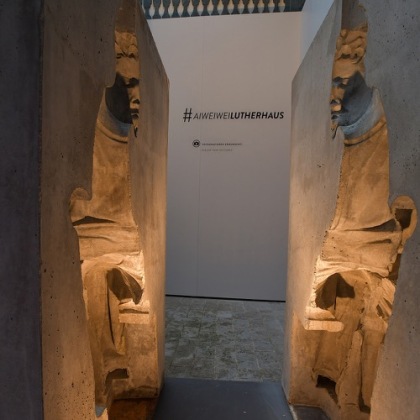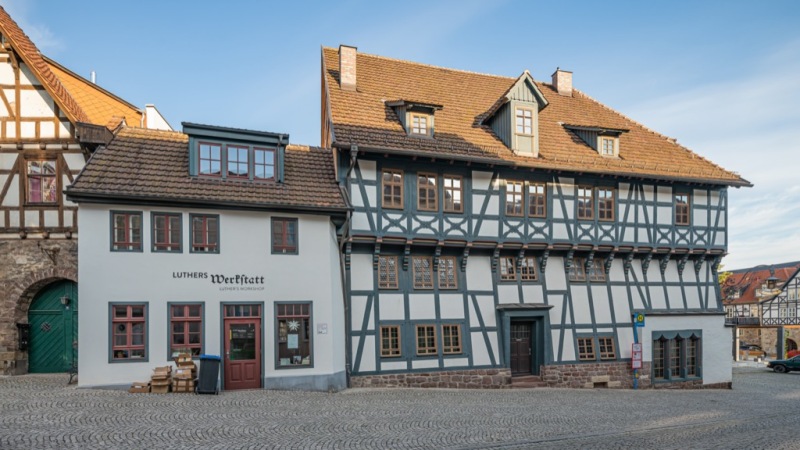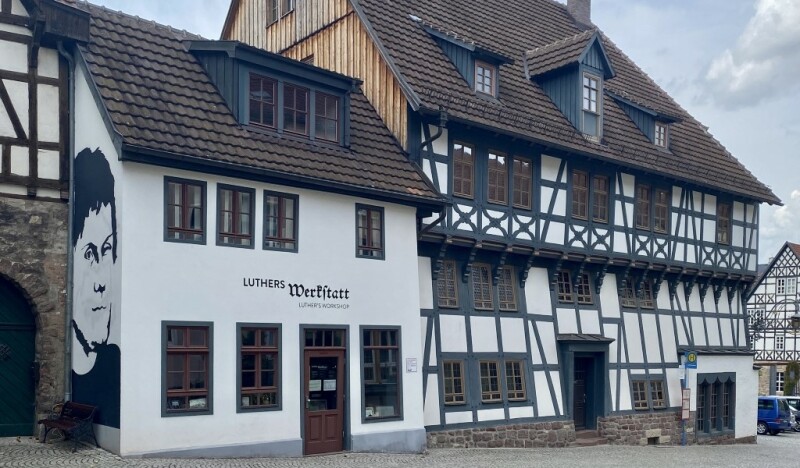Lutherhaus: All about exhibitions, prices, opening hours & directions
Inhalt
Discover the Luther House in Eisenach - an unmissable place for anyone who wants to delve deeper into the world of Martin Luther. Experience authentic insights into his life, discover a wealth of artefacts and historical documents. Immerse yourself in Luther's working environment in his workshop. Find out all about opening times, admission prices and the best route to take to visit this important place. A journey into the heart of the Reformation awaits you at the Lutherhaus - experience history up close!
Why you should visit the Luther House in Eisenach
The Luther House is a place of historical and cultural significance that offers insights into the life and times of Martin Luther and is fascinating for believers and history buffs alike.
That's why a visit to the Lutherhaus is worthwhile:
- Historical significance: The Luther House, where the young Martin Luther lived during his school years, offers an insight into his life and development before the Reformation. Visitors can learn more about his formative years here.
- Cultural heritage: The house is an authentic testimony to medieval architecture and displays exhibits documenting Luther's stay and influence in Eisenach.
- Pilgrimage site: As one of the places where Luther lived, the Luther House is a place of pilgrimage for believers and history buffs who want to learn more about the origins of the Protestant Reformation.
- Cultural events: Occasionally, cultural events, lectures and exhibitions take place in the Lutherhaus, attracting visitors interested in history, religion and culture.
What you can see in the Lutherhaus

© Norman Meißner – Fotobestand der Stiftung Lutherhaus Eisenach, CC BY-SA 4.0
- Permanent exhibition "Luther and the Bible“: The permanent exhibition is dedicated to the profound relationship between Martin Luther and the Bible. It sheds light on Luther's personal connection to the Holy Scriptures and his significant role in the translation and dissemination of the Bible. The exhibition presents Luther's passionate commitment to Bible translation, shows the historical challenges and innovations in translating into German and illustrates the impact of his work on the dissemination of the Holy Scriptures in the German language. The exhibition also illustrates the influence of Luther's Bible translation on religious, cultural and social changes during the Reformation and beyond. It enables visitors to grasp the significance of the Bible for Luther's life, his teachings and the subsequent impact on history.
- Special exhibition "Research and elimination. The ecclesiastical 'De-Jewification Institute' 1939-1945": The special exhibition sheds light on a dark and little-known side of church history during National Socialism. It focuses on the church institute for the "de-Jewification of religious life" during the Second World War. The exhibition examines the role of this institute, which, as part of the church structures in the Third Reich, was intended to purge the Bible and the Christian faith of elements considered "Jewish". It analyses the ideology, practices and impact of this institution on religious life in Germany during National Socialism, focusing on how the church was connected to the ideas of National Socialism at the time and the consequences of this collaboration. It offers an insight into the challenges faced by the church during this difficult period and encourages reflection on ethical and moral issues that are also relevant today.
- Sculpture man in a cube: The sculpture by Chinese artist Ai Weiwei is an artistic representation that is often seen as a symbol of the narrowness and limitations of human experiences and emotions. It visualises the feeling of isolation, confinement or being trapped in a limited reality or life situation. The sculpture depicts a human body enclosed in a cube or cubic structure, where this confinement can be a metaphor for emotional, physical or mental imprisonment. It invites viewers to reflect on the limitations that people face in various aspects of their lives, be it in terms of personal freedom, social barriers or emotional restrictions.
- Collection and Protestant parsonage archive: The collection in the Luther House houses a large number of historical artefacts, documents and exhibits that are closely linked to the life and work of Martin Luther. These include personal artefacts, writings, books and other relics from the time of the Reformation. The collection offers a fascinating insight into the life and historical significance of Martin Luther and the events of the Reformation period.The Protestant Parsonage Archive in the Luther House is an extensive collection of documents, writings and records from the field of Protestant church history. Among other things, it contains historical documents, theological writings, correspondence and archival documents that document the development of the Protestant faith and the history of the Protestant Church in Germany.
- Architecture: The Luther House in Eisenach is an outstanding example of late Gothic architecture and is one of the oldest town houses in the city. It is a three-storey building with a richly decorated gable, which is typical of medieval architecture in Thuringia. The architecture of the Luther House reflects the structures and features of a late Gothic dwelling. With its historical details and well-preserved interiors, it conveys an authentic picture of life in the 15th century. The Gothic windows, half-timbering and roof construction are characteristic features. Inside the house, elements from different eras have been preserved, providing an insight into the building's history and use.

© A.Savin, WikiCommons
Luther's workshop: Insights into the living and working conditions of Martin Luther
Luther's workshop in the Luther House in Eisenach is a reconstruction of his presumed place of work and study during his time as "Junker Jörg" at Wartburg Castle. It offers insights into the living and working conditions of the young Martin Luther during his time in exile.
The workshop presents replicas of tools, books and other objects that were typical of a medieval study. This exhibition gives visitors an impression of how Luther may have worked and studied during his stay at Wartburg Castle.
Although it is a reconstruction, the workshop in the Luther House offers an atmospheric idea of Luther's living space and the circumstances under which he might have lived during his time at Wartburg Castle. It is a fascinating opportunity to immerse yourself in the history of the reformer and learn more about the circumstances of his life.
Opening hours and prices
The Lutherhaus is open Tuesday to Sunday from 10 am to 5 pm. The Lutherhaus is closed on Mondays and open on public holidays. The house is closed from 24 December to 31 January. Special opening hours are possible.
What a visit to the Lutherhaus costs:
| Permanent exhibition | Special exhibition | Combination ticket | Luther Combi Ticket | |
|---|---|---|---|---|
| Individual visitors | 8.00 € | 5.00 € | 10.00 € | 10.00 € |
| Group price per person | 7.00 € | 4.50 € | 9.00 € | – |
| Reduced | 6.00 € | 4.00 € | 8.00 € | 7.00 € |
| Group price pupils per person | 5.00 € | 3.50 € | 6.00 € | – |
| Family ticket | 16.00 € | 10.00 € | 20.00 € | 25.00 € |
The combination ticket includes the permanent exhibition and the special exhibition. The Luther Combi Ticket allows admission to the permanent exhibition and is also a day ticket for all city lines in Zone A.
Reduction applies to school pupils, trainees, volunteers, students (up to 26 years of age) and severely disabled persons who are dependent on an accompanying person (severely disabled person's ID card with the suffix B).
Directions: How to get to the Lutherhaus in Eisenach
You will find the Lutherhaus at Lutherplatz 6 in Eisenach.
By car you can either park in the small paid car park in front of the Lutherhaus. Or you can park nearby, for example on the Frauenplan or in the multi-storey car park at the market.
You can walk from the train station to the city centre in the direction of the market, for example. You can also walk from the Lutherhaus to the Wartburg in around 30 minutes.
With public transport you can get directly to the Lutherhaus by bus. From the bus station, for example, you can take bus number 3 (the "Luthershuttle") to the "Lutherhaus" bus stop right next to the museum.
Cover photo: Heinrich Cotta, CC BY-SA 4.0

 DE
DE 

Questions & Comments
or post as a guest